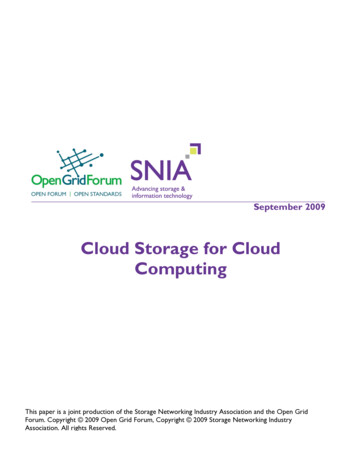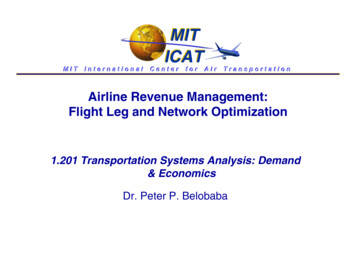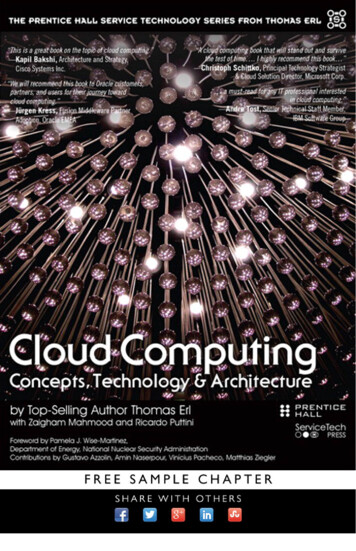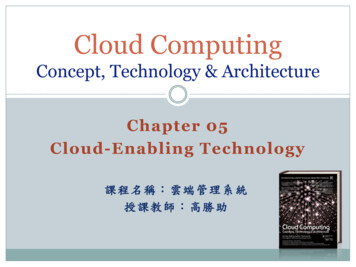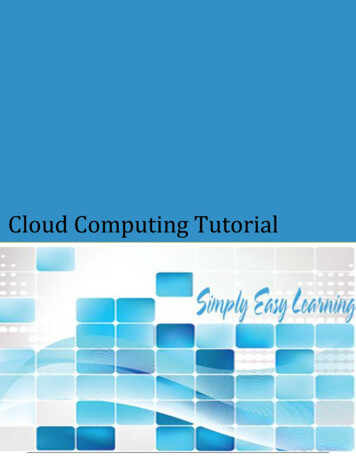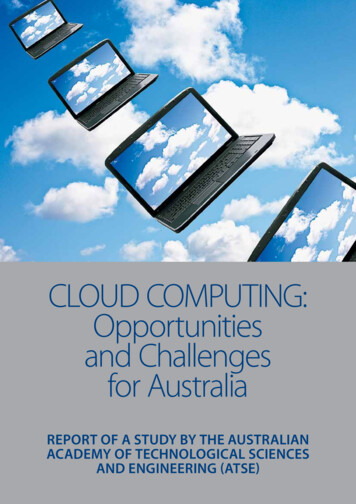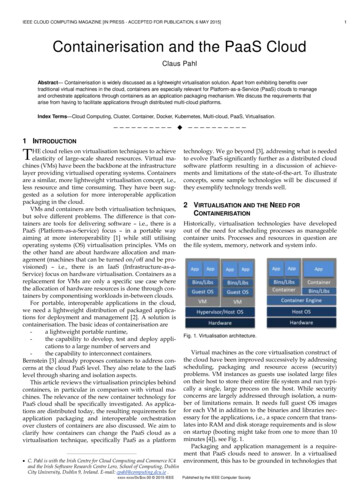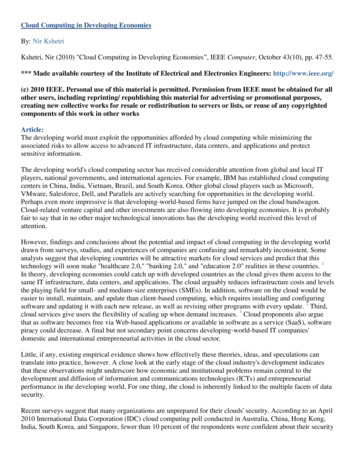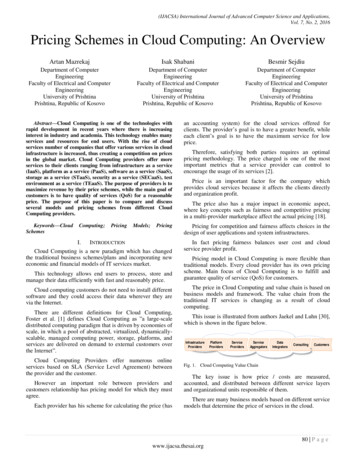
Transcription
Cloud Computing ModelsEugene GorelikWorking Paper CISL# 2013-01January 2013Composite Information Systems Laboratory (CISL)Sloan School of Management, Room E62-422Massachusetts Institute of TechnologyCambridge, MA 02142
Cloud Computing ModelsbyEugene GorelikSubmitted to the MIT Sloan School of Management and the MIT Engineering Systems Divisionin Partial Fulfillment of the Requirements for the DegreesofMaster of Management andMaster of Engineeringin conjunction with the System Design and Management Programat theMassachusetts Institute of TechnologyJanuary 2013 2013 Massachusetts Institute of Technology. All rights reservedSignature of Author .MIT Sloan School of ManagementMIT Engineering Systems DivisionCertified by .Stuart MadnickJohn Norris Maguire Professor of Information Technologies &Professor of Engineering Systems, Thesis SupervisorAccepted by .Patrick HaleDirector, System Design and Management Program
Cloud Computing ModelsComparison of Cloud Computing Service and Deployment ModelsbyEugene GorelikSubmitted to the MIT Sloan School of Management and the MIT Engineering Systems Divisionin Partial Fulfillment of the Requirements for the Master Degree in Engineering andManagementABSTRACTInformation Technology has always been considered a major pain point of enterpriseorganizations, from the perspectives of both cost and management. However, the informationtechnology industry has experienced a dramatic shift in the past decade – factors such ashardware commoditization, open-source software, virtualization, workforce globalization, andagile IT processes have supported the development of new technology and business models.Cloud computing now offers organizations more choices regarding how to run infrastructures,save costs, and delegate liabilities to third-party providers. It has become an integral part oftechnology and business models, and has forced businesses to adapt to new technologystrategies.Accordingly, the demand for cloud computing has forced the development of new marketofferings, representing various cloud service and delivery models. These models significantlyexpand the range of available options, and task organizations with dilemmas over which cloudcomputing model to employ.This thesis poses analysis of available cloud computing models and potential future cloudcomputing trends.Comparative analysis includes cloud services delivery (SaaS, PaaS, IaaS) and deploymentmodels (private, public, and hybrid). Cloud computing paradigms are discussed in the context ofThesis: Cloud Computing ModelsPage 2
technical, business, and human factors, analyzing how business and technology strategy could beimpacted by the following aspects of cloud ftware trends (commodity vs. brands, open vs. closed-source)oOrganizational/human FactorsTo provide a systematic approach to the research presented in this paper, cloud taxonomy isintroduced to classify and compare the available cloud service offerings.In particular, this thesis focuses on the services of a few major cloud providers. Amazon WebServices (AWS) will be used as a base in many examples because this cloud provider representsapproximately 70% of the current public cloud services market. Amazon’s AWS has become acloud services trendsetter, and a reference point for other cloud service providers.The analysis of cloud computing models has shown that public cloud deployment model is likelyto stay dominant and keep expanding further. Private and Hybrid deployment models are goingto stay for years ahead but their market share is going to continuously drop. In the long-termprivate and Hybrid cloud models most probably will be used only for specific business cases.IaaS service delivery model is likely to keep losing market share to PaaS and SaaS modelsbecause companies realize more value and resource-savings from software and platform servicesrather than infrastructure. In the near future we can expect significant number of marketconsolidations with few large players retaining market control at the end.Thesis Supervisor: Stuart MadnickTitle: John Norris Maguire Professor of Information Technologies & Professor of EngineeringSystemsThesis: Cloud Computing ModelsPage 3
TABLE OF CONTENTSContentsTABLE OF CONTENTS . 41INTRODUCTION . 71.1Historical background . 71.2Definition . 81.3Why Cloud Computing? . 81.3.1Elasticity . 81.3.2Pay-As-You-Grow . 91.3.3In-House Infrastructure Liability and Costs . 91.41.4.1Economies of Scale . 91.4.2Expertise . 101.4.3Commodity Hardware . 101.4.4Virtualization . 101.4.5Open-Source Software . 111.52Why Now? . 9Cloud vs. Grid. 11“CLOUD COMPUTING” – A DEFINITION . 122.1An Introduction to Cloud Architecture . 122.2Cloud Services . 152.3Building Scalable Architecture . 162.3.1Horizontal Scaling vs. Vertical Scaling vs. Automated Elasticity . 172.3.2Elasticity . 182.4Cloud Deployment Models . 192.4.13Managed Hosting . 202.5Cloud Computing Service Models. 202.6Nested Clouds . 21CLOUD ADOPTION AND CONTROL CHALLENGES . 233.1Cloud Adoption Barriers. 24Thesis: Cloud Computing ModelsPage 4
43.1.1Data Security . 243.1.2Cost Uncertainty . 253.1.3Loss of Control . 253.1.4Regulatory Compliance . 263.1.5SLA Agreements . 263.1.6Data Portability/Integration . 273.1.7Software Compatibility. 273.1.8Performance . 273.1.9Lock-In Challenges. 28TAXONOMY OF CLOUD SERVICES . 294.1Cloud Adoption and Service Offerings . 294.1.14.2Public Cloud Services Taxonomy . 31IaaS Services . 314.2.1IaaS: Storage . 324.2.2Cloud Storage Pricing . 334.2.3IaaS: Computing . 344.2.4Which Pricing Model to Choose? . 354.2.5IaaS: Network . 394.2.6IaaS: Cloud Management . 414.2.7 Interview with Sebastian Stadil, Scalr CEO and founder of Silicon Valley CloudComputing Group . 474.3PaaS Services . 494.3.1PaaS Service Characteristics . 504.3.2PaaS (SaaS): Data Analytics and Business Intelligence . 514.3.3Public Cloud BI Advantage Comes at a Cost . 544.3.4PaaS: Integration. 554.3.5PaaS: Development & QA . 574.4SaaS services . 654.4.1SaaS Business Challenge . 674.4.2Salesforce Platform Overview . 704.4.3Is Salesforce both SaaS and PaaS? . 71Thesis: Cloud Computing ModelsPage 5
5CONCLUSIONS . 725.15.1.1Public Cloud Domination . 745.1.2Open-Source vs. Proprietary Cloud Technologies . 755.2Cloud Delivery Models. 765.2.1The Thin Line between IaaS, PaaS, and SaaS . 775.2.2Cloud Adoption and Control Challenges . 785.36The Future of the Cloud Computing Market . 72Cloud Services Pricing . 78REFERENCES . 806.1Definitions . 81Thesis: Cloud Computing ModelsPage 6
1INTRODUCTION1.1 Historical backgroundThe idea of providing a centralized computing service dates back to the 1960s, when computingservices were provided over a network using mainframe time-sharing technology. In 1966,Canadian engineer Douglass Parkhill published his book The Challenge of the Computer Utility[1], in which he describes the idea of computing as a public utility with a centralized computingfacility to which many remote users connect over networks.In the 1960s, the mainframe time-sharing mechanism effectively utilized computing resources,and provided acceptable performance to users; however, mainframes were difficult to scale andprovision up-front because of increasingly high hardware costs. Accordingly, users didn’t havefull control over the performance of mainframe applications because it depended on how manyusers utilized the mainframe at a given moment. As such, with the introduction of personalcomputers users loved the idea of having full control of their computing resources, even thoughthese resources are not as effectively utilized.With the change in the semiconductor industry, personal computers became affordable, andbusiness abandoned mainframes. A new challenge was then introduced: how to share the data.Client-server systems were supposed to address this data-sharing challenge by providingcentralized data management and processing servers. As business computing needs grew and theInternet became widely adopted, the initially simple client-server architecture transformed intomore complex two-tier, three-tier, and four-tier architectures. As a result, the complexity andmanagement costs of IT infrastructure have skyrocketed – even the costs of actual softwaredevelopment in large organizations are typically lower than costs of software and infrastructuremaintenance.For many enterprises, the long-standing dream has been to background information technologyissues and concentrate on core business instead. Although the effect of the cloud computingadoption is yet to be seen, many companies believe that cloud computing may offer feasiblealternative model that may reduce costs and complexity while increasing operational efficiency.Thesis: Cloud Computing ModelsPage 7
1.2 DefinitionThere are countless definitions and interpretations of cloud computing to be found from multiplesources. The term “cloud computing” itself likely comes from network diagrams in which cloudshape are used to describe certain types of networks, either the Internet or internal networks.Some sources refer to cloud computing as a set of applications delivered as services combinedwith the datacenter hardware and software that enables the applications. Others say that cloudcomputing is a business model rather than a specific technology or service.In our opinion, cloud computing consists of both technological and business components. Certaincloud-enabling technologies significantly helped to form the cloud, and it is unlikely that cloudcomputing could have existed without them. We discuss these more closely in the next chapter,but it is worth mentioning that cloud-enablers such as open-source software, virtualization,distributed storage, distributed databases, and monitoring systems are the cornerstones of cloudinfrastructure.Cloud computing assumes that every software application or system component becomes aservice or part of a service. Therefore, the architecture of new or existing systems might have tobe changed to become cloud compatible. As such, in order to realize the value of the cloud andenable it for an organization, businesses must typically make major structural adjustments tointernal IT organizations and evangelize cloud philosophy to employees. Depending on the typeof cloud used by an organization, this may also create competition within the company. It istypical that people resist change, so cloud evangelists often face resistance within theirorganizations.1.3 Why Cloud Computing?Let’s consider a few of the most important factors that provide key incentives for organizationsto use cloud computing.1.3.1 ElasticityThe ability to scale computing capacity up or down on-demand is very important. For example,imagine a company that provides software-as-a-service (SaaS) online tax-filling services.Obviously with such a business model, this organization’s computing resource demand will peakThesis: Cloud Computing ModelsPage 8
during tax season – only two to three months each year. Financially, it doesn’t make sense toinvest up-front knowing that computing infrastructure will remain only partially utilized nine orten months per year.1.3.2 Pay-As-You-GrowPublic cloud providers like Amazon allow companies to avoid large up-front infrastructureinvestment and purchase new computing resources dynamically as needed – companies needn’tplan ahead and commit financial resources up-front. This model is particularly feasible forsmaller companies and start-ups, which often cannot afford to spend large sums of money at thebeginning of their business journey.1.3.3 In-House Infrastructure Liability and CostsRunning information technology inside the company incurs substantial liability and costs. Whilesome would argue that running infrastructure inside the organization is safer and cheaper, that’snot necessarily the case. Depending on a company’s IT budget, employee skills, and some otherfactors, it could worth running infrastructure from a public cloud. Public cloud providers couldoffer reasonable service-level agreements (SLA) and take care of the liability headaches thatcompany CIOs may face.1.4 Why Now?Why is cloud computing happening only now, instead of many years ago?1.4.1 Economies of ScaleThe enormous growth of e-commerce, social media, and various Web 2.0 services hastremendously increased the demand for computational resources. Companies like Google,Amazon, and Microsoft quickly realized that financially it is more feasible to build very largedata centers for their needs than many small ones – it is much more cost-efficient to buyresources like electricity, bandwidth, and storage in large volumes (see Table 1). In largerdatacenters, it becomes easier to maximize the amount of work per dollar spent: you can sharecomponents in a more efficient way, improve physical and virtual server density, reduce idleserver times, and cut administrator/server ratio.Thesis: Cloud Computing ModelsPage 9
Medium-sized DCVery Large DCRatio (Large-to-SmallDC)Network 95 per Mbit/sec/month 13 per Mbit/sec/month7.1Storage 2.20 per GByte/month 0.40 per GByte/month5.7Administration 140 Servers/ Admin 1000 Servers/ Admin7.1Table 1: Economies of scale in 2006 for a medium-sized datacenter (1000 servers) vs. avery large datacenter (50,000 servers). [2][3]As shown in Table 1, the cost of network bandwidth and system administration is 7.1 timescheaper, and the cost of storage 5.7 times cheaper, in 50,000-server datacenters compared todatacenters with only 1000 servers.1.4.2 ExpertiseIt takes lots of investment and technical know-how to build a datacenter. Some companiesdeveloped substantial expertise in that area. Once these companies built datacenters for theirinternal clouds, they realized that they could leverage existing expertise and technology to buildpublic cloud datacenters and offer computing services to other companies. As a result,companies like Amazon and Google became public cloud providers. (See [27] How and why didAmazon get into Cloud Computing business by Verner Vogels, CTO, Amazon)1.4.3 Commodity HardwareDrops in the costs of computer chip production, architecture standardization around the x86platform, and the increasing mechanical compatibility of internal PC components led to asignificant decrease in computer hardware costs over the past decade. Hardware affordability hascontributed to its commoditization, and accordingly reduced computational costs.1.4.4 VirtualizationHardware virtualization (see “2. Cloud Computing’ – a Definition”) has allowed increasinghardware utilization density, and ensures that hardware resources are utilized more efficiently.This is one of the technologies that enables elasticity, and so has provided increased flexibility interms of speed of deployment, dynamic auto-provisioning, and cloud management.Thesis: Cloud Computing ModelsPage 10
1.4.5 Open-Source SoftwareOpen-source software and commodity hardware are major cloud computing enablers. The Linuxoperating system in particular has become a major building block at the heart of largest cloudenvironments. Similarly, virtualization software Xen is used by Amazon to host the largest set ofvirtual machines in the world (approximately half-a-million as of now [26]), and Hadoopdistributes a computing platform that helps thousands of companies to run massive parallelcomputations in the cloud (Amazon Elastic MapReduce service). The ability to avoid expensivesoftware license costs is one of the factors that enables companies to provide affordable cloudservices.1.5 Cloud vs. GridMany experts would argue that cloud computing comes from grid computing. However, althoughthere are many similarities between cloud and grid computing, these methodologies are not thesame. The main difference is that grids were not originally created as a public on-demand utilitycomputing service, and are typically used within the same organization to run heavycomputational tasks. Cloud computing is instead normally associated with a specific service, andthat service is used as an access point providing results to the service consumer – who might be auser or another application (a B2B application, for example).Computational grids are historically used for large computational jobs and built with manyservers up-front, while the advantage of the cloud is that it can be scaled on-demand. The cloudoffers more elasticity, such that an environment can start from only a few servers, grow quicklyto hundreds of servers, and then scale back down to the initial size if required.Thesis: Cloud Computing ModelsPage 11
2“CLOUD COMPUTING” – A DEFINITIONThis chapter discusses cloud computing technology and cloud models. As an example of a publiccloud we consider Amazon Web Services (AWS), and for a private cloud VMWare cloudtechnology. These providers hold most of the market share in their specific niches, and are worthreviewing.2.1 An Introduction to Cloud ArchitectureAs the introduction notes, the idea of providing centralized computing services over a network isnot new – mainframe timesharing technology was popular as far back as the 1960s, but wasreplaced by personal computers and client-server architecture. Until around 10 years ago, typicalenterprise computing infrastructure consisted of powerful and very expensive servers.Infrastructure architecture was monolithic, and each of these powerful machines could easilyhost 20-30 enterprise applications. This market was dominated by only a few hardware vendors,such as IBM, Sun, HP, and Dec, whose servers were expensive to purchase and maintain, tookconsiderable time to install and upgrade, and in some cases were vulnerable to server outagesthat could last several hours until a vendor representative delivered proprietary replacementparts.The operating system was installed directly to hardware, and most of the servers hosted multipleapplications within the same operating system without providing physical or virtual isolation (seeFigure 1). Because it was difficult to quickly move and rebalance applications across servers,server resources were not utilized most effectively.Distributed applications, which were installed over multiple servers, communicated with eachother using CORBA or DCOM communication protocols over RPC. However, it was a majorproblem with such protocols that they were vendor-dependent, and so the implementation of onevendor might not be compatible with that of others. This was solved at the beginning of the2000s by the introduction of web services, which use open specifications that are language,platform, and vendor agnostic.Thesis: Cloud Computing ModelsPage 12
Figure 1: Servers without virtualizationWith the introduction of virtualization, things have changed tremendously. Virtualizationimproves resource utilization and energy efficiency – helping to substantially reduce servermaintenance overhead and providing fast disaster recovery and high availability. Virtualizationhas been very important for cloud computing, because it isolates software from hardware and soprovides a mechanism to quickly reallocate applications across servers based on computationaldemands (see Figure 2).Virtualization was a major step towards cloud infrastructure; however, the service componentwas still missing. Virtualized environments managed by internal system administrators and bydefault virtualization platforms do not provide the abstraction layer that enables cloud services.To cloud-enable an environment, a layer of abstraction and on-demand provisioning must beprovided on top (see Figure 3). This service layer is an important attribute of any cloudenvironment – it hides the complexity of the infrastructure, and provides a cloud-managementinterface to users. Depending on the interface implementation, a cloud-management interface canbe accessed through a management dashboard, REST or SOAP web services, programmingAPIs, or other services. For example, Amazon Web Services provides access through amanagement dashboard or REST/SOAP web services.Thesis: Cloud Computing ModelsPage 13
Figure 2: Virtualized serversFigure 3: Simplified cloud infrastructureThesis: Cloud Computing ModelsPage 14
Cloud management interfaces (for example, the Amazon admin console) provide functionsallowing users to manage a cloud lifecycle. For instance, users can add new components to thecloud such as servers, storage, databases, caches, and so on. Users can use the same interface tomonitor the health of the cloud and perform many other operations.2.2 Cloud ServicesThe cloud can provide exactly the same technologies as “traditional” IT infrastructure – the maindifference, as mentioned previously, is that each of these technologies is provided as a service.This service can be accessible over a cloud management interface layer, which provides accessover REST/SOAP API or a management console website.As an example, let’s consider Amazon Web Services (AWS). AWS provides multiple cloudinfrastructure services (see Figure 4) [4]:Amazon Elastic Compute Cloud (EC2) is a key web service that provides a facility to createand manage virtual machine instances with operating systems running inside them. There arethree ways to pay for EC2 virtual machine instances, and businesses may choose the one thatbest fits their requirements. An on-demand instance provides a virtual machine (VM) wheneveryou need it, and terminates it when you do not. A reserved instance allows the user to purchase aVM and prepay for a certain period of time. A spot instance can be purchased through bidding,and can be used only as long as the bidding price is higher than others. Another convenientfeature of Amazon’s cloud is that it allows for hosting services across multiple geographicallocations, helping to reduce network latency for a geographically-distributed customer base.Amazon Relational Database Service (RDS) provides MySQL and Oracle database services inthe cloud.Amazon S3 is a redundant and fast cloud storage service that provides public access to files overhttp.Amazon SimpleDB is very fast, unstructured NoSQL database.Amazon Simple Queuing Service (SQS) provides a reliable queuing mechanism with whichapplication developers can queue different tasks for background processing.Thesis: Cloud Computing ModelsPage 15
Figure 4: Amazon Web Services cloud [4]Here we do not describe every single Amazon service, but you can see how massive andpowerful Amazon’s cloud presence is. We review some of these services in more detail later inthis paper.2.3 Building Scalable ArchitectureOne of the most important factors in infrastructure architecture is the ability to scale. In the“traditional” non-cloud infrastructure, systems are typically architected to sustain potential futuregrowth and resource demand. Organizations must invest considerable financial resources upfront to provision for future growth. Because non-cloud infrastructures do not provide elasticity,system resources cannot quickly upscale and downscale; this leads to constant resourceoverprovisioning, and therefore systems are inefficiently underutilized most of the time.Conversely, cloud infrastructure is multi-tenant, and so computing resources are shared acrossmultiple applications. This shared multi-tenant environment is based on the assumption that allhosted applications cannot normally be busy at the same time – when one application is idle,another is busy. This way, cloud provi
Cloud computing paradigms are discussed in the context of . Thesis: Cloud Computing Models Page 3 technical, business, and human factors, analyzing how business and technology strategy could be impacted by the following aspects of cloud computing: o Architecture o Security o Costs o Ha
